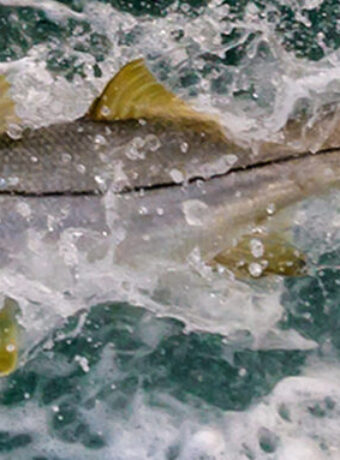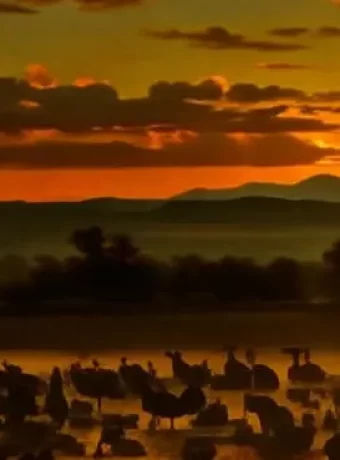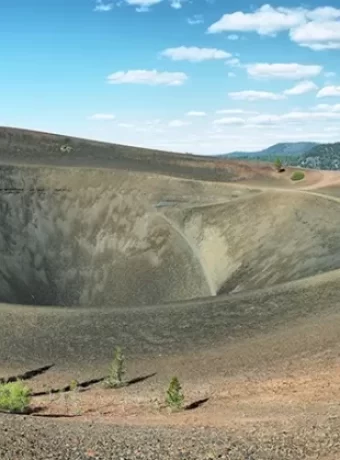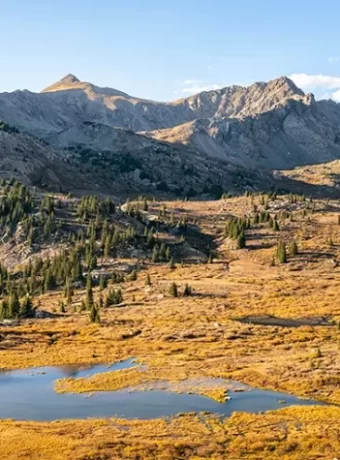Top Places to Fly Fish South Dakota for Adventure
Fly Fish South Dakota, with its crystal-clear streams and rivers, is a fly fisher’s paradise. My first trip wading into Rapid Creek, cool water rushing past, felt like stepping into a postcard. This article explores the top places to fly fish South Dakota, proving why this state belongs on your list.
Whether you’re a beginner or a seasoned angler with your favorite fly rod and waders, South Dakota has something for all skill levels. Explore these diverse fishing opportunities throughout the state.
Table of Contents
Top Places to Fly Fish South Dakota
South Dakota offers incredible fly fishing. Choosing the right fly can enhance your fishing experience. Check the local fishing regulations and secure necessary permits beforehand.
Rapid Creek
Rapid Creek flows through Rapid City, blending urban access with natural beauty. It’s home to various trout species. Challenge yourself by fishing right in the heart of town.
Spearfish Creek
Spearfish Creek meanders through the Black Hills National Forest. Wild rainbow trout flourish in its waters, which average 29 feet wide. The canyon walls and surrounding forests create a stunning backdrop for your fly fishing adventure in South Dakota.
Fly Fish Spearfish Creek
Spearfish Creek is a top spot for fly fishing in South Dakota’s Black Hills. The creek’s clear waters are truly something special. They’re also home to lots of trout. This makes it a great place to test your fly fishing skills. The scenery around the creek is gorgeous too. Think pine trees and rolling hills.
But what makes Spearfish Creek so good for fly fishing? Well, it has different sections. This means there’s something for everyone. Beginners can try the slower parts. More experienced anglers can tackle the faster runs. The creek is also easy to get to. You can find good spots right off the road.
This doesn’t mean it’s always simple to fish Spearfish Creek. The trout here can be picky. They’ve seen lots of flies. But that’s part of the fun, right? Figuring out what they want. It’s a good test for any fly fisherman.
So, what flies should you use on Spearfish Creek? It depends on the season and the conditions. But some good choices are Blue-Winged Olives (BWOs), Stimulators, and Elk Hair Caddis. These dry flies often work well. Because they imitate the insects that live around the creek. Nymphs like Hare’s Ear and Pheasant Tail are good too. Especially when the fish are feeding below the surface.
If you’re up for a challenge, try fishing Spearfish Creek with streamers. Woolly Buggers and Muddler Minnows can be really effective. These streamers imitate small baitfish. They can attract some big trout. Just remember to check the local fishing rules before you go. And make sure you have the right permits.
Spearfish Creek is just one of many amazing fly fishing spots in South Dakota. But it’s definitely one of the best. With its clear water, plentiful trout, and beautiful scenery, it’s a place you won’t want to miss. So pack your gear and get ready for a memorable fly fishing adventure.
Spring Creek
Spring Creek, fed by Sheridan Lake near Pierre, offers prime fly fishing from September through early November. Target brown and rainbow trout in this recovering creek.
Fish can become skittish in autumn.
Find out more information about Spring Creek fly fishing opportunities.
French Creek
French Creek, in Custer State Park, presents a unique challenge from April to early September due to large fly hatches. Fish for brown, rainbow, and brook trout. Cast from accessible spots or hike between Grace Coolidge Campground and Center Lake for more solitude. View the interactive Public Fishing Access Map for more details.
Fly Fish French Creek
Tucked away in Custer State Park, French Creek is a fly fisherman’s dream. This Black Hills hidden gem offers cold, clear water perfect for trout. The creek meanders through gorgeous scenery. Think towering pines and granite outcroppings. This makes for a peaceful, almost magical fly fishing experience.
The creek’s size makes it ideal for wading. You can easily cast your line into promising pockets and runs. Because it’s a smaller creek, lighter tackle is often best. This lets you present your flies delicately. This is often the key to success on French Creek.
While French Creek may be a bit off the beaten path, it’s well worth the trip. The trout here are known for their feistiness. This gives anglers a fun challenge. The surrounding beauty adds to the overall experience. It’s a place where you can truly connect with nature and enjoy some top-notch fly fishing in South Dakota.
Bring your favorite dry flies, nymphs, and maybe even a few streamers. You never know what the trout might be in the mood for. But remember to check the local fishing regulations first. This helps you make sure you’re fishing legally and responsibly.
If you’re looking for a more secluded fly fishing adventure in the Black Hills, give French Creek a try. It’s a special place that offers both a challenging and rewarding experience. It’s perfect for those who enjoy the peace and quiet of nature.
Castle Creek
Castle Creek, a tributary of Deerfield Reservoir, offers excellent brook trout fishing. Naturally reproducing trout thrive in this stretch. Access the creek easily from the gated fishery near the designated parking area.
Fly Fish Deerfield Reservoir
Deerfield Reservoir, nestled in the Black Hills of South Dakota, offers amazing fly fishing. This 9,000-acre lake gives you plenty of space to cast your line. The scenery? Absolutely stunning, with pine-covered hills all around. It’s a peaceful escape, but also a thrilling spot to hook some trout.
Deerfield holds rainbow, brown, and brook trout. Because the lake is so big, finding the best spots might take some work. But that’s part of the adventure! Many anglers have success fishing from the shore. But you can also rent a boat for better access to the deeper water. This lets you cover more ground and try different techniques.
Fly fishing at Deerfield Reservoir changes with the seasons. During spring, the trout are hungry after the winter. They’ll go after dry flies like Blue-Winged Olives (BWOs) and Elk Hair Caddis. As the water warms in summer, fish start to move deeper. So, try nymph patterns such as Hare’s Ear and Pheasant Tail. These imitate the insects trout feed on under the surface. When fall arrives, the fish become active again. This makes streamers like Woolly Buggers and Muddler Minnows great choices. These mimic small baitfish that trout hunt. Even in winter, you can ice fish on Deerfield Reservoir. Just make sure the ice is thick enough for safety.
Before you head out, it’s important to check the South Dakota fishing regulations. Make sure you have the right fishing license and understand any special rules for Deerfield. Also, consider hiring a local guide. A guide can show you the best spots, give you tips on fly selection, and help you have a successful day on the water. They can even share some cool stories about the area. Whether you’re a seasoned fly fisherman or just starting, Deerfield Reservoir is a fantastic place to experience the beauty of South Dakota. And maybe even catch a few trout while you’re at it!
Pactola Reservoir and Tailwater
Pactola Reservoir, west of Rapid City, is home to brown and rainbow trout, including the elusive wild brown trout. The tailwaters below the spillway are rumored to hold large trout. The reservoir features a marina, boat launches, walking paths, and a campground. Plan your adventure at Pactola Lake.
Sheridan Lake
Sheridan Lake, a man-made reservoir, is located on the site of the first Pennington County seat. Fish for lake trout, brown trout, and rainbow trout. Managed by the National Forest Service, it provides shore fishing and boat access.
Plan your next memorable fishing trip to Sheridan Lake.
Stockade Lake
Stockade Lake in Custer State Park provides year-round fishing for trout, perch, and bluegill. Remember to obtain the required access permits for South Dakota state parks and recreational areas.
Lake Sharpe
Lake Sharpe, a large Missouri River reservoir, offers fly fishing opportunities for walleye, smallmouth bass, and catfish. Explore its quiet coves and shorelines.
Fly Fish Lake Sharpe
Lake Sharpe sits right in the middle of South Dakota. It’s a reservoir on the Missouri River. This place offers some amazing fly fishing. But it’s different than fishing a stream. You’ll need to adjust your approach.
This lake holds lots of walleye. These fish are hungry for smaller fish. So, your fly selection matters. Think baitfish patterns. Woolly Buggers and Muddler Minnows are great choices. These streamers mimic what walleye eat. Try different colors to see what works best.
Smallmouth bass also call Lake Sharpe home. They like rocky areas and points. So, focus your efforts there. Poppers and other topwater flies can be very effective. These exciting fish will smash a fly on the surface.
While not as common, you might also hook some trout. Rainbow and brown trout sometimes move into the lake from feeder streams. This can make for a fun surprise. Try using nymphs or small streamers.
Wind can be a factor on Lake Sharpe. It can make casting a fly rod tricky. Because of this, watch the weather. Pick calmer days for a better experience. Early mornings and evenings are usually less windy.
A boat gives you the best access to Lake Sharpe’s fishing spots. But you can also fish from shore. Look for areas with structure, like rocks or submerged trees. These areas attract fish.
Remember to check the South Dakota fishing regulations. You’ll need a valid fishing license. Also, be aware of any special rules for Lake Sharpe.
Consult the Current Closure Maps for safe access points on the Missouri River system.
Francis Case Reservoir
Francis Case Reservoir, also on the Missouri River, is another excellent spot for walleye Fly Fishing. Try different fly fishing techniques.
Fly Fish Francis Case Reservoir
Francis Case Reservoir, also known as Lake Francis Case, isn’t just a pretty face. This sprawling South Dakota reservoir, part of the Missouri River system, is a fantastic place to fly fish. It offers a diverse fishery with plenty of room to roam. So, grab your fly rod and get ready for some action!
Walleye, smallmouth bass, and northern pike are the stars of the show here. But, you can also find other species like crappie and white bass. This variety adds to the excitement of fly fishing Francis Case. You never know what you might hook into next. The reservoir’s sheer size means you can explore many different areas. This helps you find the perfect fishing spot. Whether you like fishing near the dam, along the shoreline, or in the backwaters, there’s a place for you.
Fly fishing on Francis Case Reservoir is a bit different than fishing a small stream. Because of the reservoir’s size, a boat is often helpful. This lets you cover more water and reach areas holding fish. But, shore fishing is definitely possible too. Many access points along the shoreline make it easy to cast a line. Look for areas with structure, like points, submerged trees, or rock piles. These are fish magnets.
Choosing the right flies is important for success on Francis Case. For walleye, try Clouser Minnows, Jig Flies, or Woolly Buggers in natural colors. Smallmouth bass often hit poppers, streamers, and crayfish patterns. And if you’re after northern pike, large, flashy streamers are the way to go. Don’t forget about the other species! Small nymphs and dry flies can work well for crappie and white bass.
South Dakota’s weather can change quickly, so be prepared. Dress in layers and check the forecast before you head out. Wind can be a factor on Francis Case, so be ready for some breezy conditions. But, this is a small price to pay for the amazing fly fishing opportunities this reservoir offers. So, pack your gear, and come explore this hidden gem in the heart of South Dakota.
Sand Creek
Sand Creek, a Blue Ribbon Water near the Wyoming border and Sturgis, offers brown and rainbow trout fishing. Spring through early autumn provides particularly rewarding experiences.
Winter Trout food sources are scarce during these times.
Fly Fish Sand Creek
Tucked away in the northeastern corner of South Dakota, Sand Creek offers a different kind of fly fishing thrill. It’s not as famous as some Black Hills streams, but that’s part of its charm. This creek flows through prairie landscapes, giving you a sense of solitude you won’t find everywhere. The slower currents and warmer waters make it a haven for warm-water species.
While trout are the stars of many South Dakota streams, Sand Creek is home to smallmouth bass, northern pike, and even walleye. This means you’ll want to adjust your fly selection. Think streamers, poppers, and large dry flies that imitate baitfish, frogs, or mice.
Sand Creek often gets overlooked by anglers chasing trout. This makes it perfect for those who want a peaceful experience away from the crowds. The creek meanders through grasslands, offering beautiful views and lots of spots to cast your line. You might even see some wildlife, like deer or pheasants, along the banks. The fishing might be a bit slower than on a fast-moving trout stream. But the chance to hook a feisty smallmouth or a big northern pike is definitely worth the wait.
Because Sand Creek is less pressured, the fish can be a little less picky. This makes it a great place for beginners to try their hand at fly fishing. But don’t think it’s too easy! Experienced anglers will also enjoy the challenge of figuring out what these fish are hungry for. Try different retrieves and fly patterns to see what works best. You might be surprised at what you hook into.
One important thing to keep in mind about Sand Creek is the changing water levels. The flow can fluctuate quite a bit depending on rainfall and irrigation upstream. Check the local conditions before you go. This will help you choose the right flies and the best spots to fish.
So, if you’re looking for a South Dakota fly fishing adventure that’s a bit off the beaten path, give Sand Creek a try. It’s a great spot to connect with nature, escape the crowds, and test your skills against some hard-fighting fish.
Fly Fish Sheridan Lake
Sheridan Lake isn’t just for boaters and swimmers. It’s a fantastic place to fly fish in South Dakota. The lake has lots of trout. You can find rainbow, brown, and lake trout swimming around. This variety makes it exciting. You never know what you’ll catch!
Shore fishing is easy at Sheridan Lake. There’s plenty of shoreline access. You can cast from the banks or wade into the shallows. Because the lake is so big, you can really spread out. You can find your own quiet spot to fish.
A boat opens up even more fishing spots on Sheridan Lake. A float tube lets you drift along. This is a great way to cover water. You can try different depths and areas. Many anglers use small boats with electric motors. This lets them quietly explore the lake.
What flies should you use? Because Sheridan Lake has lots of insects, dry flies work well. Try a Blue-Winged Olive or an Elk Hair Caddis. These imitate the bugs trout like to eat. If dry flies aren’t working, try a nymph. Pheasant Tails and Hare’s Ears are good choices. These sink below the surface. They can tempt trout feeding deeper down.
Fly fishing at Sheridan Lake is a great experience for everyone. Beginners can find shallow areas to practice their casts. Experienced anglers can test their skills with the larger lake trout. The scenery is beautiful too. The Black Hills surround the lake. This makes it a peaceful place to fly fish South Dakota.
Whitewood Creek
Whitewood Creek provides accessible fishing for stocked and wild trout in the Black Hills. The creek is easily accessible to locals and newcomers. Find more about fishing records in the state fishing records using interactive dashboards. This historic spot provides a great fly fishing experience.
Fly Fish Whitewood Creek
Whitewood Creek, a tributary of the Belle Fourche River, is a fly fisherman’s dream. This spot in the Black Hills offers a peaceful setting. The creek meanders through the pines. This creates deep pools perfect for trout. It’s a great place to escape the crowds. You’ll find yourself lost in the quiet beauty of nature. This makes for a more relaxing fly fishing experience.
The clear, cold water of Whitewood Creek is ideal for trout. Brown trout are common here. You might also hook a rainbow or brook trout. The creek’s healthy insect population provides a steady food source. This keeps the trout active and hungry. So, get ready for some exciting action on your fly rod!
Because the creek is smaller than the Belle Fourche River, it offers a different kind of challenge. Accuracy is key here. You’ll need to carefully present your flies to the trout. A delicate approach is often best. The reward is the thrill of catching trout in a pristine environment.
Think about using dry flies during the warmer months. The trout in Whitewood Creek are known to rise to the surface. Blue-Winged Olives (BWOs) and Elk Hair Caddis are great choices. But, nymphs can be effective year-round. Try a Pheasant Tail or Hare’s Ear nymph. These will often tempt the trout hiding deeper in the pools.
Whitewood Creek offers something for all skill levels. Whether you’re a seasoned angler or just starting out, this creek is a fantastic choice. It’s a place where you can connect with nature. You can improve your fly fishing skills. And, you might just catch the biggest trout of your life as you fly fish South Dakota.
Belle Fourche River
Fly fishing the Belle Fourche River in the Black Hills National Forest offers ample shore access. This river crosses state lines, so be aware of fishing regulations for South Dakota, Montana, and Wyoming. Check license requirements before your adventure.
Fly Fish Belle Fourche River
The Belle Fourche River is a fly fisherman’s dream. It winds through the Black Hills of South Dakota. This river offers beautiful scenery and great fishing. The river is home to brown trout, rainbow trout, and even some smallmouth bass. This makes it a great spot for anglers of all skill levels.
One of the best things about the Belle Fourche River is its variety. The river has different sections. Some sections are fast-paced and exciting. Others are slower and calmer. This lets you choose your adventure. You can find pocket water, riffles, and long, deep pools. Each spot holds different fish and requires different techniques.
If you’re new to fly fishing the Belle Fourche, start with the slower sections. These areas are perfect for practicing your casts. They’re also home to plenty of hungry trout. As you get more comfortable, try some of the faster water. This is where you can find bigger fish. But be prepared for a challenge!
What flies should you use on the Belle Fourche? Well, it depends on the time of year and what the fish are eating. But some good choices include Blue-Winged Olives (BWOs), Elk Hair Caddis flies, and Parachute Adams. For nymphs, try Hare’s Ear, Pheasant Tail, and Copper John. If you’re after bigger fish, try streamers like Woolly Buggers or Muddler Minnows.
Don’t forget to check the local fishing regulations. Make sure you have the right permits. This will help you fish responsibly and keep this beautiful river healthy. The Belle Fourche River is a special place. It’s a place where you can get lost in nature. So, pack your gear, grab your rod, and get ready for an unforgettable fly fishing adventure.
Little Spearfish Creek
Little Spearfish Creek, near Spearfish, is a hidden gem for anglers seeking wild rainbow trout. This pristine tributary requires longer hikes through rugged landscapes, making it more challenging. Discover scenic views and secluded fishing pools.
Fly Fish Little Spearfish Creek
Little Spearfish Creek is a fly fisherman’s dream. This Black Hills hidden gem tumbles down from the mountains. The creek offers clear, cold water perfect for trout. This creek is a tributary of Spearfish Creek. It’s smaller but holds plenty of fish. The scenery here is breathtaking. Think towering pines and granite outcrops. You’ll feel miles away from everything. But you’re still close to amenities. This makes Little Spearfish Creek ideal for a quick fishing trip. Or you can make it part of a longer Black Hills adventure.
The trout in Little Spearfish Creek are eager to take a well-presented fly. You’ll find rainbow, brown, and brook trout here. They’re hungry and ready to bite. Because the creek is smaller, accuracy is important. A delicate presentation is key to success. This is where your fly fishing skills are really put to the test. But the reward is worth the effort. There’s nothing like the thrill of landing a trout on a tiny stream.
When it comes to flies, consider these choices for Little Spearfish Creek:
- Dry Flies: A Blue-Winged Olive (BWO) is a good choice. This fly mimics the mayflies common in the area. A Stimulator is another good option. It resembles a variety of insects. This makes it attractive to a range of trout.
- Nymphs: A Hare’s Ear nymph is a classic for a reason. It imitates various mayflies and caddisflies. The Pheasant Tail is another versatile choice. It’s effective for trout and even smallmouth bass if you find any.
- Streamers: While dry flies and nymphs are often preferred in smaller streams, a small Woolly Bugger can be effective. This fly imitates baitfish and leeches.
This creek is perfect for wading. You can easily move from pool to pool. Look for deeper pockets and undercut banks. These are prime spots where trout like to hang out. Because this is a smaller creek, stealth is important. Move slowly and carefully. Avoid making sudden movements. This will keep the trout from getting spooked.
Remember to check the local fishing regulations before you go. Get any needed permits. Respect the environment and leave no trace. With its stunning beauty and eager trout, Little Spearfish Creek is a fly fish South Dakota experience you won’t soon forget. This creek offers a true escape for the adventurous angler. A very Fly Fish South Dakota Adventure.
Spearfish Canyon
Spearfish Canyon, with its multiple waterfalls, offers diverse fishing opportunities. Fish along the Spearfish Canyon Scenic Byway between Spearfish and Lead. Explore various easily accessible fishing locations.
Fly Fish Spearfish Canyon
Spearfish Canyon is a fly fisherman’s dream. The canyon’s beauty makes a stunning backdrop for a day on the water. The clear, cold streams of Spearfish Creek wind through towering limestone cliffs and ponderosa pines. This makes a great spot for both seasoned anglers and beginners.
Spearfish Creek is the main attraction, but don’t overlook its tributaries. Little Spearfish Creek offers more secluded spots. This is perfect if you want a quiet fly fishing experience. Both creeks hold a healthy population of trout. You have a good chance of catching rainbow, brown, and brook trout.
The best time to fly fish Spearfish Canyon is spring and fall. The weather is mild and the water is clear. But, summer can also be good. Just be prepared for more crowds and potentially warmer water temperatures. Early mornings and late evenings are often the most productive times to fish, especially during the summer months.
If you are new to fly fishing, Spearfish Canyon has some help available. Local guides can teach you the basics. They can also show you the best spots. Several fly shops in the area can give you advice on what flies to use. They also sell or rent equipment if you need it. Remember to get your South Dakota fishing license before you go.
What flies should you use in Spearfish Canyon? Dry flies like Blue-Winged Olives (BWOs), Stimulators, and Elk Hair Caddis are often effective. Because the water is so clear, you might want to use some smaller nymphs too. Pheasant Tails, Copper Johns, and Zebra Midges are all good choices. If you want to try streamer fishing, Woolly Buggers and Muddler Minnows can tempt larger trout.
Beyond fly fishing, Spearfish Canyon has a lot more to do. Hiking trails crisscross the canyon. These trails offer stunning views. You can also try rock climbing or simply relax by the creek. Spearfish Peak and Roughlock Falls are worth a visit. So, if you’re looking for an outdoor adventure, Spearfish Canyon has something for everyone. Just remember to pack your fly rod and fly fish South Dakota!
Top Fly Fishing Flies for South Dakota
Dry Flies
Blue-Winged Olive (BWO): A must-have for any South Dakota fly fisherman, the BWO imitates the abundant mayflies found in the state’s streams and rivers.
Stimulator: A versatile fly that imitates a variety of insects, the Stimulator is effective for trout and smallmouth bass.
Elk Hair Caddis: A popular dry fly for South Dakota’s streams and rivers, the Elk Hair Caddis imitates the abundant caddisflies.
Parachute Adams: A classic dry fly that imitates a variety of mayflies and caddisflies, the Parachute Adams is a reliable choice for South Dakota’s trout.
Royal Wulff: A high-visibility dry fly that imitates a variety of insects, the Royal Wulff is effective for trout and smallmouth bass.
Nymphs
Hare’s Ear:
A classic nymph that imitates a variety of mayflies and caddisflies, the Hare’s Ear is a staple in any South Dakota fly fisherman’s box. I personally prefer a hare’s ear soft hackle.
Pheasant Tail:
A versatile nymph that imitates a variety of insects, the Pheasant Tail is effective for trout and smallmouth bass. Again a flashback soft hackle I have found more effective.
Copper John: A popular nymph that imitates a variety of insects, the Copper John is effective for trout and smallmouth bass.
Prince Nymph: A reliable nymph that imitates a variety of insects, the Prince Nymph is effective for trout and smallmouth bass.
Zebra Midge: A small but effective nymph that imitates a variety of midges, the Zebra Midge is a must-have for South Dakota’s trout.
Streamers
Woolly Bugger:
A classic streamer that imitates a variety of baitfish and leeches, the Woolly Bugger is effective for trout and smallmouth bass.
Muddler Minnow: A popular streamer that imitates a variety of baitfish and leeches, the Muddler Minnow is effective for trout and smallmouth bass.
Black Stonefly: A streamer that imitates the abundant stoneflies found in South Dakota’s streams and rivers, the Black Stonefly is effective for trout.
Baitfish Streamer: A streamer that imitates a variety of baitfish, the Baitfish Streamer is effective for trout and smallmouth bass.
Remember to always check the local fishing regulations and adjust your fly selection based on the time of year, water conditions, and target species. Tight Lines, Happy fly fishing in South Dakota!
FAQs about Top Places to Fly Fish South Dakota
Is there good fly fishing in South Dakota?
Yes, South Dakota provides excellent fly fishing. The Black Hills region boasts over 375 miles of trout streams. Many of these streams are wild and pristine, offering excellent day trips.
Local fishing guides are available in South Dakota’s urban centers.
Convenient supply shops are stocked with fly fishing equipment.
Where is fly fishing the most popular?
While Montana is well-known, South Dakota offers excellent fishing, especially in lesser-known areas. These regions can provide better opportunities for catching large brown and rainbow trout. They experience fewer seasoned anglers than neighboring states or countries known for trophy trout.
What is the rarest fish in South Dakota?
The pallid sturgeon, a federally endangered fish, is the rarest in South Dakota. This river dweller can reach up to six feet long. While you’re unlikely to see one, be aware that it’s protected in its waters, including the Cheyenne and White rivers. South Dakota offers a wide range of fish species, from small trout to large sturgeon.
Where to catch trout in South Dakota?
The Black Hills provides excellent trout fishing in Rapid, Spearfish, and Spring Creeks, along with the Belle Fourche River and Pactola Reservoir. Numerous smaller streams, including Crow Creek, French Creek, and Little Spearfish Creek, offer plentiful trout fishing spots. Many banks are easily accessible from roadsides, providing ample parking. For increased seclusion, consider lesser-fished areas requiring smaller off-road vehicles. Always check South Dakota’s Current Closures map for restrictions before heading out.
Conclusion of Fly Fish South Dakota
This article highlighted the top places to fly fish in South Dakota, focusing primarily on trout. Consider exploring areas like Lake Sharpe for walleye and Palisades State Park near Sioux Falls for smallmouth bass fishing. Split Rock Creek near the park offers prime smallmouth fishing opportunities near the Blue Diamond and King and Queens trails just across the state line.
South Dakota provides rewarding fishing opportunities that can be your next fishing success story. Don’t be afraid to explore less-traveled paths for bigger catches.






